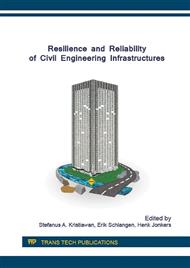[1]
D.S. Agustawijaya, A review on hazard risk reduction systems and reliability estimate of the dredging system of the Lusi mud volcano in Sidoarjo, East Java, Int. J. Civil & Env. Eng. 13 (02) (2013) 12-16.
Google Scholar
[2]
D.S. Agustawijaya, Sukandi, The stability analysis of the Lusi mud volcano embankment dams using FEM with a special reference to the Dam Point P. 10. D, Civil Eng. Dimension, 14 (2) (2012) 100-109.
DOI: 10.9744/ced.14.2.100-109
Google Scholar
[3]
D.S. Agustawijaya, Penanggulangan semburan dan penanganan luapan lumpur Sidoarjo: Peranan ilmu dan rekayasa kebumian dalam pengelolaan bencana, Proceeding of National Seminar of Indonesian Geographer Association (IGI), Surabaya, December 2010, 16-28, (in Bahasa Indonesia).
Google Scholar
[4]
D.S. Agustawijaya, Syamsuddin, The development of hazard risk analysis method: A case study in Lombok Island, Dinamika Teknik Sipil, 12 (2) (2012) 146-150.
Google Scholar
[5]
A. Mazzini, H. Svensen, G.G. Akhmanov, G. Aloisi, S. Planke, A. Malthe-Sorenssen, B. Istadi, Triggering and dynamic evolution of Lusi mud volcano, Indonesia, Earth & Planetary Sci. Lett. 261 (2007) 375-388.
DOI: 10.1016/j.epsl.2007.07.001
Google Scholar
[6]
Anonym, Annual Report, Deputy of Operation, BPLS, Surabaya, 2013 (in Bahasa Indonesia).
Google Scholar
[7]
H.Z. Abidin, R.J. Davies, M.A. Kusuma, H. Andreas, T. Teguchi, Subsidence and uplift of Sidoarjo (East Java) due to the eruption of the Lusi mud volcano (2006-present), Env. Geology, Springer-Verlag, (2008) doi: 10. 1007/s00254-008-1363-4.
DOI: 10.1007/s00254-008-1363-4
Google Scholar
[8]
Y. Fukushima, J. Mori, M. Hashimoto, Y. Kano, Subsidence associated with the Lusi mud eruption, East Java, investigated by SAR interferometry, Mar. & Petro. Geology, 26 (2009) 1740-1750.
DOI: 10.1016/j.marpetgeo.2009.02.001
Google Scholar
[9]
M. S Islam, M.S.H. Swapan, S.M. Haque, Disaster risk index: How far should it take account of local attributes?, Int. J. of Disaster Risk Red., 3 (2013), 76-87.
DOI: 10.1016/j.ijdrr.2012.10.001
Google Scholar
[10]
M.N. Ahsan, J. Warner, The socioeconomic vulnerability index: A pragmatic approach for assessing climate change led risk – A case study in the south-western coastal Bangladesh. Int. J. of Disaster Risk Red., 8 (2014) 32-49.
DOI: 10.1016/j.ijdrr.2013.12.009
Google Scholar
[11]
H. Pan, P. Shi, T. Ye, W. Xu, J. Wang, Mapping the expected fatality risk of volcano on a global scale. Int. J. of Disaster Risk Red. 13 (2015) 52-60.
DOI: 10.1016/j.ijdrr.2015.03.004
Google Scholar
[12]
H. Andreas, H.Z. Abidin, M.A. Kusuma, P. Sumintadireja, I. Gumilar, Ground displacement around Lusi mud volcano Indonesia as inferred from GPS surveys, FIG Congress: Facing the Challenges – Building the Capacity, Sydney, 11-16 April (2010).
Google Scholar
[13]
M.L. Rudolp, M. Shirzaei, M. Manga, Y. Fukushima, Evolution and future of the Lusi mud eruption inferred from ground deformation, Geophy. Res. Lett. 40 (2013) 1-4, doi: 10. 1002/grl. 50189.
DOI: 10.1002/grl.50189
Google Scholar
[14]
M. Lupi, E.H. Saenger, F. Fuchs, S.A. Miller, Lusi mud eruption triggered by geometric focusing of seismic waves, Nature Geosci. 6 (2013) 642-646, doi: 10. 1038. ngeo1884.
DOI: 10.1038/ngeo1884
Google Scholar
[15]
Sungkono, A. Husein, H. Prasetyo, A.S. Bahri, F.A. Monteiro Santos, B.J. Santosa, The VLF-EM imaging of potential collapse on the Lusi embankment, J. Appl. Geophysics, 109 (2014) 218-232.
DOI: 10.1016/j.jappgeo.2014.08.004
Google Scholar
[16]
A. Husein, B.J. Santosa, A.S. Bahri, Seepage monitoring of an embankment dam using resistivity method: A case study of the Lusi mud volcano. Appl. Mech. and Mat. 771 (2015) 213-217.
DOI: 10.4028/www.scientific.net/amm.771.213
Google Scholar


